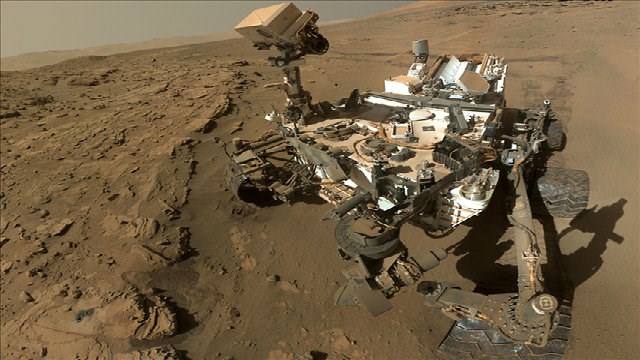December 17, 2014 – Move over Earth. You are probably no longer the sole source of life in the Universe, or even in the Solar System. A tenfold spike in methane gas detected by the Mars Sample Analysis laboratory as well as organic molecules found in powder collected from a Curiosity drill hole points to a likely biological source. Of course the Jet Propulsion Laboratory (JPL) scientists are describing it as possibly biological or non-biological. The presence of the methane could be the result of some exotic chemistry native to Mars. But in combination with the finding of organic molecules in Martian rocks, suggests biology was and maybe is present. Certainly the spiking of methane gas indicates something active in the present.
The discovery has been a closely guarded secret at JPL for several months. First the scientists wanted to make sure that any organic molecules found in the rock powder were not brought to Mars on Curiosity itself. Some are present inside the rover and their identity is known. Eliminating them still left unexplained organic compounds that could only be of Martian derivation.
A further complication in sampling Martian organic compounds comes from the presence of perchlorate minerals which have been found at the Phoenix and Curiosity landing sites. The perchlorate present in the organic samples when cooked in the on board laboratory alters their structures.
Multiple samplings at different places in Gale Crater and on Mount Sharp should verify that these earlier discoveries are no flukes. NASA published the results of the methane findings in the journal Science.
It is these methane findings that are most intriguing. Whereas organic compounds found in rocks may be evidence of past life, methane fluctuations in the Martian atmosphere speaks to something happening in the present.
The sampling done by Curiosity over 20 months measured four spikes in methane, rising from 0.7 parts per billion to 7.0. On Earth methane comes from living things and once live things. Termite mounds emit methane. Marshlands as well. Cows and other livestock are an enormous methane source. You and I just like livestock pass methane gas from our gut to the atmosphere. Man-made wetlands like rice paddies produce huge quantities of the gas. And even the oceans produce methane trapped in icy sediments (methane hydrates) or from decaying organic matter. Besides the ocean’s icy sediments we find methane produced from the mining and combustion of fossil fuels including coal, oil and natural gas. And finally, when we throw out the things we consume into landfill, we create another rich source of organic matter that emits methane.
There is one non-organic source for methane gas on Earth. It comes from the Earth’s mantle, the 2,900 kilometer thick semi-solid layer of rock beneath the Earth’s crust. In this subterranean area of our planet, where pressures are 50 to 100,000 times that of our atmosphere and temperatures exceed 2,500 Celsius (4,500 Fahrenheit) degrees, methane forms when iron oxide, calcite and water interact. This subterranean methane can be found at depths between 100 and 200 kilometers (62 to 124 miles).
Could a similar chemical interaction on Mars produce the results Curiosity has reported? The answer is no. An ongoing present source is the only explanation for the current methane spikes that the rover has detected. And the likely source, whether NASA is prepared to admit it or not, is organic.
Of course we still don’t have a living microorganism to show from the rover’s sojourn on the planet. But we sent Curiosity to Mars not to discover life but to look for evidence of organics and water. And now it has found both.












